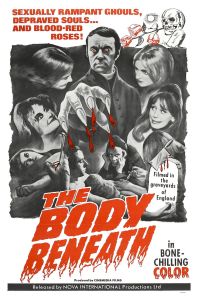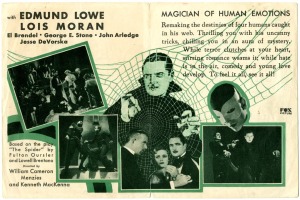 (photo provided by author Rod Labbe given to him by Joan Fontaine )
(photo provided by author Rod Labbe given to him by Joan Fontaine )
THE LION IN WINTER:
JOAN FONTAINE’S LOST ACTING TRIUMPH!
By Rod Labbe
With Joan Fontaine
INTRODUCTION: A dark and chilly night, January, 2012.
I’d just gotten home from our local supermarket and was lugging multiple sacks, boxes, and slippery soda bottles into the kitchen. That’s when my cell rang. Displaying finely-tuned athletic dexterity–and, might I add, lightning-fast reflexes–I bounced from foot to foot, grabbed for the phone and breathlessly gasped, “Hello?”
“Yes, hello. Is Rod in, please?” A woman…and her mellifluous voice sounded vaguely familiar.
“Speaking.” Two dozen “cage-free” eggs were slowly slipping out of their bag. “Excuse me if I seem distracted. Things are a bit crazy here. I’m balancing several grocery items and trying very hard not to drop them. ”
“Oh? I’ll call back later, if now isn’t convenient.”
‘No, no. Potential disaster averted! How can I help you?”
“This is Joan Fontaine…”
“Who?”
“Joan Fontaine.”
“Um…hi.” The eggs fell, and I suddenly found myself incapable of stringing two coherent syllables together.

Ok, ok, a bit theatrical, but it’s not like I converse with legendary movie stars every day. Who among us wouldn’t be discombobulated? True, I’d written an article about Miss Fontaine (entitled “A Study in Tenacity,” Classic Images, October 2008) and mailed her a complimentary copy. My contact information, ahem, just happened to be enclosed. But did I honestly expect a response? Nooo.
Apparently, Joan Fontaine preferred a pro-active approach. She thanked me for the CI piece (“Delightful!”), discussed salient points and segued smoothly into the big request.
“I have an interesting proposition, Rod,” she said. “Are you accustomed to being propositioned, long-distance?”
“Can’t say that I am,” I chuckled.
“Well, I’m primarily a film actress, but my best role–the one I feel defines me–was Eleanor of Aquitaine in a Viennese stage production of William Goldman’s, The Lion in Winter (1979). That career highpoint has received very little fanfare. You’re a good writer. Why don’t we collaborate on an article and address History’s oversight? Posterity needs us!”
“Certainly! I’m honored to be asked, Ms. Fontaine.”
“Wonderful. And please, it’s Joan. Let me send you what I have, and we’ll chat again.”
Within days, I’d received Joan’s archival material (consisting of newspaper reviews) but needed more. A treasure hunt ensued. I scoured the Internet, checked and rechecked facts at libraries and archives and scratched my head, utterly confused. Joan and I spoke a few more times, and random bits coalesced.
Then, I had a brainstorm: why not contact Vienna’s English Theatre directly?
I did and hit the jackpot! Information poured like honey. Paragraphs were tweaked here and there, and an article chronicling a lost moment in Joan Fontaine’s professional life emerged.
Lost, no longer.
PART ONE: From Film to Theater
Success as a performing artist can mean many things: world fame, better seating at restaurants, an increased bank account, and the very real possibility that failure and obscurity are waiting around the proverbial corner.
How much energy did Michael Jackson expend trying to deliver another Thriller (1982)? Despite cinematic high-points, like Meet me in St. Louis (1944), A Star is Born (1954), and Judgment at Nuremberg (1961), is it any great surprise Judy Garland’s ruby slippers remain firmly planted on the yellow brick road?
Creative pinnacles reached in milieus not usually associated with an artist’s publically-accepted persona present new, decidedly unique scenarios. Pundits scratch their heads; scholars ponder ways of dissecting the phenomenon, while (oddly enough) fans/aficionados and followers are oftentimes blissfully unaware.
Take Joan Fontaine, world famous as an Academy Award winning actress from Hollywood’s “golden era,” for example.
Millions have seen Rebecca (Selznick-1940); Suspicion (RKO-1941); This Above All (Fox-1942); Jane Eyre (Fox-1944), and Letter from an Unknown Woman (UI-1948), motion pictures rightly deemed classics and all starring Joan Fontaine as leading lady.

Rebecca, especially, proved a seminal work. Based upon Daphne DuMaurier’s popular novel and directed by Alfred Hitchcock–his first American assignment (courtesy of independent producer, David O. Selznick)–it scored an impressive eleven Oscar nominations and won Selznick his second Best Picture statuette, following Gone With the Wind (MGM-1939).

Ginger Rogers’ dramatic tour de force as Kitty Foyle (RKO) dazzled Academy voters that year, but Joan’s Best Actress nomination generated the most industry buzz. “Olivia de Havilland’s baby sister, you know,” Hollywood gushed, agog. “So gifted, so refreshing, so pretty and unaffected! Where has she been all our lives?”
Gone forever were programmers like Music for Madame (RKO-1937) and The Duke of West Point (UA-1938). At age 23, Joan Fontaine stepped out from the immense shadow of an older, established movie star sibling and blossomed into a bona-fide “A-Lister.”
Her second cinematic foray with Hitch, Suspicion–ostensibly, a dramatic vehicle for light comedian, Cary Grant–pushed Joan to even greater cinematic heights. Once again, there was talk of Oscar.

Said Bosley Crowther (New York Times, November 21, 1941), “This young lady has unquestionably become one of the finest actresses on the screen, and one of the most beautiful, too; and her development in this picture of a fear-tortured character is fluid and compelling all the way.”
Academy voters concurred. February 26, 1942, against powerhouse competition (Bette Davis, Greer Garson, Barbara Stanwyck and, in one of Hollywood’s greatest upsets, Olivia), they named Joan Fontaine 1941’s “Best Actress,” the sole performer to win an Oscar for a Hitchcock film, supporting or leading.

Suspicion established the Fontaine template: shy heroines with backbones of steel. Later, she defied conformity by adding do-gooders, troubled women, schemers, a Victorian-era murderess, arch, globe-trotting sophisticates, and a nuclear submarine saboteur to her resume, demonstrating truly remarkable diversity.
Amazingly, Joan never saw any of her films after Frenchman’s Creek (Paramount-1944)! “That was a deliberate decision,” she said. “I went to the opening of Frenchman’s Creek in NYC (Radio City), against my better judgment, and the audience started laughing uproariously at a scene where Basil Rathbone attacked me. Right then and there, I vowed never to watch another film of mine, and I haven’t.”

Three Oscar nominations (Rebecca, Suspicion, and The Constant Nymph, 1943), an Academy Award, and forty-six movies notwithstanding, Joan’s performance in a theatrical endeavor was her favorite. And done only twice.
To understand how and why this occurred, let’s go back to 1954. That’s the year she replaced Deborah Kerr on Broadway in Tea and Sympathy. Columnists and theatergoers alike were smitten by Joan’s multi-layered interpretation of “older woman,” Laura Reynolds. Elia Kazan directed, and Anthony Perkins (subbing for John Kerr) co-starred.
Wrote Joan, in her best-selling autobiography, No Bed of Roses (William Morrow, 1978):
“During rehearsals, I was feeling my way from just ‘being-and-feeling’ in front of the camera to the projection of voice and personality across the footlights, beyond the proscenium arch. My debut at the Ethel Barrymore Theatre was a most terrifying experience. Brooks Atkinson, of the New York Times, reviewed me very favorably, though I hadn’t been on the stage since 1941. Tony Perkins got excellent reviews as well, starting him on a long and successful career.”

“Through training, an actor learns to move and feel from his toes up. His ear must be quick to detect intonation, emphasis, cadence, stress. It must also be able to twitch! The director guides, bring out, enlarges, controls. But the actor must come to the stage equipped with the technique, the talent, the ambition, the imagination, the patience. The theatre audience is the ultimate teacher, instructing the actor on the degree to which he has executed both the author’s and the director’s intent.”

Joan elaborated later, in one of our marathon phone sessions: “Theatre’s immediacy cannot be discounted. There’s a full-bloodedness to each living word and action. You’re nervous, you’re edgy, and that energy is extremely potent and can actually help an actor.”
“But does the same energy drive a film performance?” I inquired.
“Film is notoriously more difficult because you’re not cohesive. You may start at the end or the middle and be that person, wherever you start, and carry the role in you, hidden, as it were. The cutter puts it all together, hopefully to your advantage,” she laughed.

Tea and Sympathy opened new career doors. From then on, Joan regularly trod the boards between film assignments with Forty Carats (Broadway, 1968-70), Private Lives; Dial M for Murder; Relatively Speaking, and Cactus Flower–well-received and profitable, but none tapped into her core, the center of what defined Joan Fontaine as an actress.
That would come much later, with The Lion in Winter, presented at Vienna’s English Theatre in October of 1979.
 (Foyer- Vienna’s English Theatre)
(Foyer- Vienna’s English Theatre)
Ironically, this opportunity originated from a film connection: The Devil’s Own (Fox, 1967–aka The Witches), directed by Cyril Frankel, under the aegis of England’s Hammer Studios.

PART TWO: Lightning in a Bottle
A welcomed return to form, The Devil’s Own showcased Joan’s still formidable talents as teacher Gwen Mayfield–fearless heroine battling voodoo, witchcraft, intrigue and treachery in an idyllic English village. Again, the actress proved pro-active; she’d optioned Norah Lofts’ (pseudonym, “Peter Curtis”) best-selling thriller and wooed Michael Carreras, Hammer’s head honcho. He liked the package of book and star and produced with 7-Arts, a happy, mutually satisfying project for everyone concerned.

The New York Times (March 16, 1967) lauded their combined effort: “Say this for Joan Fontaine, who has finally trailed other middle-years movie queens like Bette Davis, Joan Crawford and her own sister, Olivia de Havilland, into the shocker school. Miss Fontaine picked herself the best property, in this beautifully woven yarn of a new teacher in a village school who is suddenly aware that the cheerful place and its people are not all they seem….and Cyril Frankel, the director, does a smashing job of depicting the seemingly placid routine of the rural background, the kind of thing mastered by Agatha Christie. But the light brush strokes and edge of terror are entirely original here.”

“She brings a good deal of intelligent preparation to a highly emotional role,” Frankel told The Daily Cinema (April 29, 1966). “Her sense of dramatic imagination is very strong indeed.”

Likewise, Joan spoke highly of her director: “From the very first day we met, Cyril and I had simpatico. We’ve kept in touch all these years, and he wired me about The Lion in Winter. Of course, I agreed to do it. Our rehearsals lasted four weeks in London. It was a thorough production, from start to finish.”

The Lion in Winter is an historical drama that takes place throughout the Christmas holidays, 1183, in Windsor, England. King Henry V has gathered together his three surviving adult sons: Richard, Geoffrey and John, and his banished (and imprisoned for ten years) wife, Queen Eleanor. Their eldest child–Henry’s namesake–died the previous summer, so England’s future crown is up for grabs. Which royal head will wear it?
Eleanor, an expert conniver, favors Richard and bestows upon him her inherited land, the Aquitaine. Henry prefers youngest son, John, a questionable choice–John’s fidgety, immature, and hardly able to assume any significant leadership responsibility. No one takes notice of Geoffrey, the most qualified. Possessing wit, intelligence, and an inherent ability to scheme, he’s ignored in the never-ending tug of war between his parents.
Henry has kept himself a mistress, Alais, sister of France’s King Philip II. When Philip arrives to reinforce a treaty signed between King Louis I (Alais’ and Philip’s father) and Henry, promising Alais to Henry’s rightful heir, drama escalates.
 (Windsor Castle Tower,rebuilt by Henry II in stone replacing the old wooden tower )
(Windsor Castle Tower,rebuilt by Henry II in stone replacing the old wooden tower )
If England’s proper successor cannot be chosen, there’s sure to be civil war. At stake are sundry lands and possessions, not to mention the throne itself. A series of promises broken turns brother against brother, husband against wife, sons against parents, with an ambitious mistress fueling the fires of discontent.
Keenly aware that Eleanor suffers in captivity, Henry extends an olive branch: he’ll grant her freedom for the Aquitaine, thus diffusing Richard’s bargaining position. She agrees but has one caveat: Alais and Richard must marry immediately.
Richard discovers the betrayal and rejects Alais. Unbeknownst to either Eleanor or Henry, he’s carrying on a romantic liaison with Philip, further complicating matters.
Raging, Henry disowns his entire family and imprisons them, declaring that intended bride-to-be Alais will beget him another suitable heir.

(Church of Fontevraud Abbey Eleanor of Aquitaine and Henry II effigies )
Eleanor is beaten for the moment and has no choice but acquiescence. Alais, in the meantime, convinces Henry that his adult sons pose dire threats. She wants them incarcerated for life; otherwise, neither she nor her progeny are safe.
Machinations escalate. Eleanor smuggles daggers to Richard, John and Geoffrey and encourages their escape. They refuse, intent on killing Henry–a prospect more attractive in the planning. Held back by love and skewered sentiment, they cannot do the deed. Likewise, he cannot kill them.
The Christmas holidays near a dissatisfying end. No son has England’s throne, Eleanor retreats into exile, and Henry and Alais are still unmarried. Nothing’s changed.
At its core, The Lion in Winter revolves around two cosmically-entwined individuals torn apart by human frailties. The drama is underscored by tragedy and deceit and painful disappointment.

Goldman’s play had its Broadway debut March 3, 1966 and ran a total of 92 performances. Robert Preston gave star power to Henry, and Rosemary Harris was an elegant Eleanor (’66 Tony Award for Best Actress in a Play).
Nonetheless, Goldman’s use of anachronistic language, historical inaccuracies and attempts at humor were thumped as more Marx Brothers than Shakespearean.
Missteps aside, the play’s message rings clear: nothing is worse than a dysfunctional family at Christmas!
The Lion in Winter roared back as a very successful and sumptuously-mounted film, released by Joseph E. Levine’s Avco-Embassy Pictures, in 1968.

Peter O’Toole and Katharine Hepburn led an expert cast, and TLIW garnered seven Academy Award nominations, including Best Picture, Best Director (Anthony Harvey), Best Actor (O’Toole), and Hepburn for Best Actress (she took home the Oscar, her third, sharing honors with first-timer, Barbra Streisand).
Goldman also won for his screenplay, and he and director Harvey admirably expanded the play’s scope. Dramatic intimacies, however, are what make The Lion in Winter crackle, and effective use of close-ups caught every nuance.
A second version ran on Showtime, the cable television network, in 2003, starring Glenn Close and Patrick Stewart and utilizing Goldman’s original screenplay. Stewart received kudos for bringing new sensitivity to the dialogue, but Close was crushed by Hepburn’s towering Eleanor.

The play had a second Broadway go-round in March 1999, with Laurence Fishburne and Stockard Channing as Henry and Eleanor. Like Rosemary Harris, Channing scored a Tony nomination, losing to Judi Dench (Amy’s View).

“Goldman controlled his property,” Joan revealed, “and didn’t want to do it in England. They’d criticized the script, and he absolutely refused to do it there. As for me, Goldman didn’t know who the hell I was! I saw that as an advantage; anonymity meant breathing room and no predetermined estimation of my capabilities.”
Watching Joan Fontaine work live is a distinct pleasure, but Eleanor was so different from anything in her repertoire, it threw theatre-goers for a proverbial loop.
Miss Fontaine’s re-emergence is quite starting,” raved the International Herald Tribune, on Tuesday, October 16, 1979. “She bursts on the scene with a ripe, fiery radiance. Her remembered screen image is one of a demure, soft-spoken damsel. She has matured into an actress of sweeping command…her voice, once the organ of muttered sweet nothings, now has resonance and volume. She had majestic stride and presence, robust humor and a sense of the dramatic, which overcome the play’s obvious shortcomings.”
Reflected Joan, “I saw The Lion in Winter on Broadway and thought it was simply fascinating. Eleanor is an actor’s dream–what possibilities! The characters exude extraordinary vitality, but Eleanor’s the eye of this storm. Calm, unpredictable…and oh-so dangerous.”
 (Photo Provided by Vienna’s English Theatre )
(Photo Provided by Vienna’s English Theatre )
Wiener Zeiting, Austria’s 300 year-old newspaper, wrote, “Joan Fontaine is, like the character she plays, a very imposing apparition, with great personality and with many attributes at her disposal. The grand dame, the mother, the politician, the ruler, the strategist, the abandoned, the one full of feeling, the calculating and sharp-tongued–all this she brings together under one common denominator, with her dark, intriguingly deep voice–a woman of the great world.”
In particular, Cyril Frankel’s direction had scribes swooning.
“A sample of his innovation: when for a moment the rude, noisy traffic slows for a spell, and Miss Fontaine’s Eleanor utters a desperate, lonely cry, he blacks out the stage and spotlights her face,” rhapsodized The International Herald Tribune (October 16, 1979). “As she renders her inner lament in an unexpected rush of pathos, the earth-bound lines she speaks deceptively yield the illusion of grandeur.”
 (Photo provided by Vienna’s English Theatre )
(Photo provided by Vienna’s English Theatre )
I asked Joan if she was surprised by the enthusiastic reviews. Here’s what she had to say:
“Oh, completely. Critics are a testy bunch. Our first show was an artistic triumph. Afterwards, a reporter interviewed me in my dressing room. The stage manager was impatient because we were late for an opening night party. I wanted to cool down, but off we went, directly into the cold Vienna air–and I ended up hospitalized with a nasty case of pneumonia.”
“Alas, we did only two shows in Vienna,” she divulged. “The others were cancelled due to my illness. I really should have taken out an ad in Variety and The Hollywood Reporter to thank all our critics, but illness prevented me. I stayed in a hotel room for two weeks until I could get my strength to come back to the US.”
Strange, isn’t it? Joan Fontaine has contributed to Film, the stage and television, written her life story and brought home an Academy Award. Weighed individually, those accomplishments are remarkable enough, but the one milestone she’s proudest of flared quickly and brightly, like fireworks bursting in a nighttime sky.
“I was pleased with everything, from the production elements, to Cyril’s empathetic direction, Simon Merrick’s Henry, and the unflagging support of those involved. Later, I toured with the play stateside, but nothing compared to Vienna,” sighed Joan, nostalgically. “It was the pinnacle of my acting career–lightning in a bottle. I’ve never been so personally satisfied. Or tested.”
“Looking back, I emulated Eleanor without realizing it. Those situations don’t happen often for an actor, if at all. An enchanting serendipity.”
Note:
Joan Fontaine passed away December 15th, 2013, at age 96. I’m fortunate to have met and worked with such a remarkable human being.
She is now immortal.































































































































































 (photo provided by author Rod Labbe given to him by Joan Fontaine )
(photo provided by author Rod Labbe given to him by Joan Fontaine )














 (Windsor Castle Tower,rebuilt by Henry II in stone replacing the old wooden tower )
(Windsor Castle Tower,rebuilt by Henry II in stone replacing the old wooden tower )





